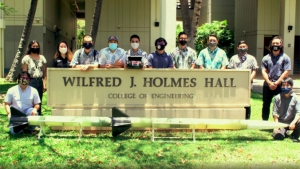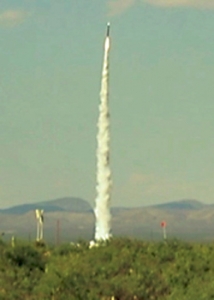Ready, set, liftoff!
Members from University of Hawaiʻi at Mānoa’s Team Hōkūlele are headed to Mojave, Calif., to launch their 15-foot rocket and payload in a national competition. The project by College of Engineering students was accepted into the Friends of Amateur Rocketry (FAR) 1030 Competition happening on June 5.
The students will launch their rocket called Kuamoʻo (Milky Way) in the competition’s 30,000-foot category, a cruising altitude for some commercial airplanes. Along with the altitude requirement, their objectives are to: launch the rocket with live video, deploy a rover vehicle upon landing and recover all components in reusable condition. Team Hōkūlele and the other competing college and amateur teams will launch their rockets from the FAR rocketry range near Edwards Air Force Base.
Blake Yamamoto, the team’s senior design project manager, said this project is the culmination of two years of work since last year’s team was unable to compete due to the COVID-19 pandemic.
“It’s really exciting. I still have contact with some of the previous team members so even they’re really excited to see this thing fly,” Yamamoto said.
Rocket and payload

Kuamoʻo is the first two-stage/motor rocket for Team Hōkūlele, which was established in 2019. The rocket is designed to reach a height of at least 30,000 feet and safely protect all of its components from liftoff to touchdown. The team also created a radio-controlled rover capable of traveling a distance of at least 10 feet after touchdown, and needed to ensure that the rover and its deployment system are durable enough to survive any sustained impacts.
Aiden Guzman is the senior design team propulsion and recovery subsystem lead. His task was to decide what motors will be used, and run the simulations to make sure that the rocket will fly and descend safely to and from an altitude of 30,000 feet.
“Since I took on a lead position it helped me gain experience in giving others tasks, coordinating testing/work days with big groups of people, integrating each system of the rocket making sure that none of them interfere with each other and resource acquisition,” Guzman said. “Also before this project, I was very timid, but now I am very comfortable asking a lot of questions. Even if you decide not to go into the aerospace field, this position will give anyone experience to become a project manager for any system.”
Vertically integrated project

Team Hōkūlele is part of UH Aerospace Technologies, one of more than a dozen Vertically Integrated Projects or VIPs offered to students at UH Mānoa. VIPs are uniquely designed to include faculty mentors, graduate student researchers, and undergraduates from freshmen to seniors. The more experienced members mentor newer members, passing down their knowledge and expertise, and the process repeats itself annually.
The team comprises two separate groups: VIP students and students from a Department of Mechanical Engineering senior design course. They are mentored by UH Mānoa’s Hawaiʻi Space Flight Laboratory Specialist and Project Manager Trevor Sorensen, and Assistant Specialist and Deputy Director Miguel Nunes.
“The VIP team members all work under or alongside the senior design team members, who serve as subsystem leads,” said Leah Toma, VIP manager. “This results in a sort of pipeline that helps the VIP team gain experience prior to their senior year, which helps to ensure the sustainability and success of the team, since knowledge and skills can be passed down easily.”
Previous success

Two members of the current team, including Toma, traveled with the 2019 team to compete at the Spaceport America Cup competition in New Mexico. The students successfully launched their rocket named Kahekili with two experimental payloads. Toma said this year’s team looks to build on the foundation started by the team’s first-ever competition in 2019.
Funding assistance
Team Hōkūlele received approximately $19,500 in funding and support from several organizations, including the College of Engineering, Engineers Council of the University of Hawaiʻi, RM Towill Corporation, Fiberglass Hawaii, Pacific Instruments, ʻIolani School, Coffman Engineers, Hawaiian Dredging and Universal Manufacturers. Pacific Air Cargo has also offered to transport the rocket from Hawaiʻi to California and back.
This program is an example of UH Mānoa’s goals of Excellence in Research: Advancing the Research and Creative Work Enterprise (PDF) and Enhancing Student Success (PDF), two of four goals identified in the 2015–25 Strategic Plan (PDF), updated in December 2020.
—By Marc Arakaki

